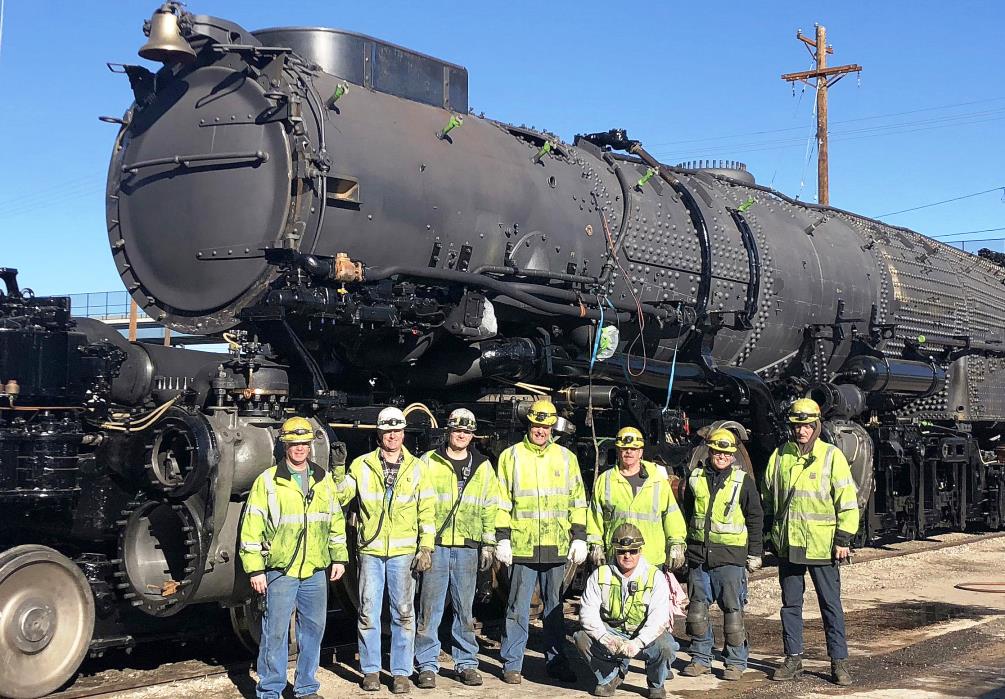At the Union Pacific restoration shop in Cheyenne, Wyoming, Union Pacific steam locomotive Big Boy No. 4014 rolled out on May 4, 2019 for its big debut after five years of restoration.
It’s longer than two city buses, weighs more than a Boeing 747 fully loaded with passengers and can pull 16 Statues of Liberty over a mountain.
Big Boys hauled freight between Wyoming and Utah in the 1940s and 1950s. Of the 25 built by the American Locomotive Company in Schenectady, New York, from 1941 to 1944, eight remain. Only No. 4014 will be operational.
“It’s a pretty big deal,” said Jim Wrinn, editor of Trains magazine. “Nobody ever thought that a Big Boy would be restored to operation. Ever.”
Union Pacific hasn’t said how much the restoration cost, but Wrinn estimated at least $4 million based on similar restorations.
A key moment during the restoration occured in January of this year, when the Union Pacific Steam Team hoisted the Big Boy’s more than 250-ton boiler and rear engine into the air with two massive cranes and reconnected it to its front engine. Getting to that connection moment was a complicated endeavor.
Articulated steam locomotives have two sets of drivers – or complete engine units – with eight wheel sets total. The front set of driving wheels, referred to as the front engine, can move independently from the locomotive’s permanently attached boiler and rear engine. This allows the locomotive to better negotiate curves.
Big Boys are referred to as simple articulated locomotives because the live steam is used only once before it’s exhausted out the stack. This type of locomotive creates a very characteristic sound because the two engines work independently from each other and exhaust steam independently, creating a unique “chuff” cadence.
The heaviest of the Big Boy’s wheel sets are called the main drivers. Weighing in at more 16,000 pounds each, these wheel sets are connected to the locomotive’s four main rods. The rods connect to the Big Boy’s four pistons.
High pressure steam powers these massive wheel assemblies via a complex network of large pipes connected by huge moveable ball joints. The joints connect the front engine’s throttle and superheater header. The header is the large manifold – or casting arrangement – that connects the Big Boy’s network of small pipes, called super heaters, to the front engine’s steam chest. The Steam Team had to meticulously restore and reassemble these parts before the reconnection project could begin.
“This is very heavy work,” said Ed Dickens, head of the Union Pacific Steam Team. “It requires diligent workmanship and close machining tolerances to achieve the results we are delivering. The last time Union Pacific had an articulated locomotive disassembled for this level of repair was in the 1950s.”
The articulation joint is the main attachment point connecting the two engines. Between the front engine and smoke box are two exhaust ball joint castings that together weigh more than a ton.
“We picked up the Big Boy’s front engine with heavy side boom cranes and a large cable sling – a heavy steel cable connected to the two cranes – underneath the smoke box, just like they would have done decades ago,” Dickens said. “We hoisted the boiler and rear engine up, and carefully connected the two back together. We then lowered it down very incrementally until all the heavy components fit together.”
When all was said and done, the Big Boy’s rear engine pushes down with about 14,000 pounds of force on the front engine’s articulation tongue joint. The articulation tongue joint is the connection point between the two engine frames.
“It was a very exciting moment,” Dickens said. “We just looked at it all together and posed for a group photo before getting back to work. We’re making very rapid progress, and it’s another milestone checked off the list.”
The next huge milestone in No. 4014’s restoration is hydrostatic testing the locomotive’s boiler. The hydrostatic inspection uses warm water under hydraulic pressure to test the entire boiler structure.
Dickens said the project is on schedule, and coming together nicely, but the team isn’t relaxing yet.
“We have a lot of work ahead of us, but most of the heavy-duty work is done,” he said. “It’s just a matter of meticulous welding, and a lot of little things we have to do. As we enter the testing and adjustment phases of this project, the tests are confirming the solid conditions of our workmanship.”

